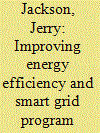| Srl | Item |
| 1 |
ID:
096743


|
|
|
|
|
| Publication |
2010.
|
| Summary/Abstract |
Electric utilities and regulators face difficult challenges evaluating new energy efficiency and smart grid programs prompted, in large part, by recent state and federal mandates and financial incentives. It is increasingly difficult to separate electricity use impacts of individual utility programs from the impacts of increasingly stringent appliance and building efficiency standards, increasing electricity prices, appliance manufacturer efficiency improvements, energy program interactions and other factors. This study reviews traditional approaches used to evaluate electric utility energy efficiency and smart-grid programs and presents an agent-based end-use modeling approach that resolves many of the shortcomings of traditional approaches. Data for a representative sample of utility customers in a Midwestern US utility are used to evaluate energy efficiency and smart grid program targets over a fifteen-year horizon. Model analysis indicates that a combination of the two least stringent efficiency and smart grid program scenarios provides peak hour reductions one-third greater than the most stringent smart grid program suggesting that reductions in peak demand requirements are more feasible when both efficiency and smart grid programs are considered together. Suggestions on transitioning from traditional end-use models to agent-based end-use models are provided.
|
|
|
|
|
|
|
|
|
|
|
|
|
|
|
|
| 2 |
ID:
097598


|
|
|
|
|
| Publication |
2010.
|
| Summary/Abstract |
Electric utilities and regulators face difficult challenges evaluating new energy efficiency and smart grid programs prompted, in large part, by recent state and federal mandates and financial incentives. It is increasingly difficult to separate electricity use impacts of individual utility programs from the impacts of increasingly stringent appliance and building efficiency standards, increasing electricity prices, appliance manufacturer efficiency improvements, energy program interactions and other factors. This study reviews traditional approaches used to evaluate electric utility energy efficiency and smart-grid programs and presents an agent-based end-use modeling approach that resolves many of the shortcomings of traditional approaches. Data for a representative sample of utility customers in a Midwestern US utility are used to evaluate energy efficiency and smart grid program targets over a fifteen-year horizon. Model analysis indicates that a combination of the two least stringent efficiency and smart grid program scenarios provides peak hour reductions one-third greater than the most stringent smart grid program suggesting that reductions in peak demand requirements are more feasible when both efficiency and smart grid programs are considered together. Suggestions on transitioning from traditional end-use models to agent-based end-use models are provided.
|
|
|
|
|
|
|
|
|
|
|
|
|
|
|
|
| 3 |
ID:
097188


|
|
|
|
|
| Publication |
2010.
|
| Summary/Abstract |
This paper reviews current capital budgeting practices and their impact on energy efficiency investments. The prevalent use of short payback "rule-of-thumb" requirements to screen efficiency projects for risk is shown to bias investment choices towards "sure bet" investments bypassing many profitable efficiency investment options. A risk management investment strategy is presented as an alternative to risk avoidance practices applied with payback thresholds. The financial industry risk management tool Value-at-Risk is described and extended to provide an Energy-Budgets-at-Risk or EBaR risk management analysis to convey more accurate energy efficiency investment risk information. The paper concludes with recommendations to expand the use of Value-at-Risk-type energy efficiency analysis.
|
|
|
|
|
|
|
|
|
|
|
|
|
|
|
|